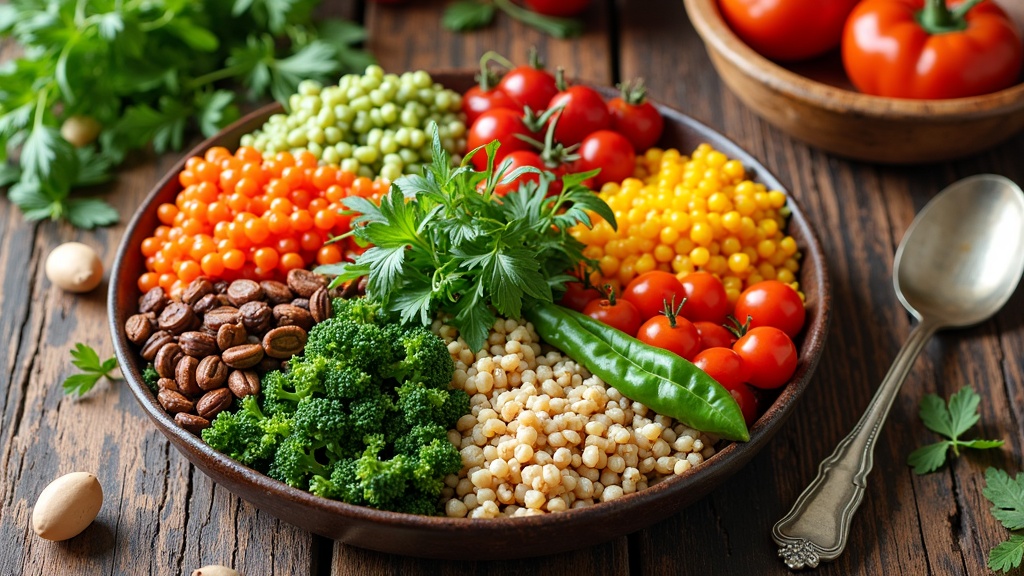Plantbased cooking goes far beyond simply swapping out animal products for veggies and beans.
Chefs who focus on this approach know all sorts of ways to bring out big flavors, create satisfying textures, and load each plate with eye-catching bursts of color.
To stir up some inspiration, I’ve put together top insights and favorite recipes from talented plantbased chefs who spend their days making plants seriously delicious.

Why Plantbased Chefs Love These Recipes
Making the switch to more plantbased meals might seem like a big move, especially if you’re used to cooking with animal products.
But chefs who work with plants every day have loads of tips for creating food that’s not just tasty, but deeply satisfying as well.
They agree on one thing: The creativity and variety make plantbased cooking irresistibly fun and never boring.
Some people go plantbased for health, others want to help the environment or animals.
No matter your reason, having a solid list of tried-and-true recipes makes plantbased cooking approachable and way more enjoyable.
Professional chefs lead the way, mixing classic culinary tricks and clever substitutions to create meals you’d be excited to serve to anyone—even diehard meat eaters.
Getting Started in Plantbased Cooking
If you’re just jumping into plantbased eating, it helps to start with recipes that don’t stray far from dishes you already enjoy.
Pastas, curries, hearty salads, and stews are natural fits that don’t require meat or dairy to shine.
Chefs repeatedly stress the importance of loading up on flavor and using the freshest, highest-quality ingredients you can track down.
Here are some key plantbased swaps picked up from the pros:
- Use Nuts or Seeds for Creaminess: Cashews and sunflower seeds easily blend into thick, rich sauces, dreamy soups, and creamy desserts without using dairy.
- Layer Spices and Herbs: Don’t hold back here. Double the fresh herbs, or add big pinches of bold spices like cumin, smoked paprika, or turmeric for next-level cool flavor.
- Roast, Grill, and Sauté for Texture: High-heat cooking brings out deep flavor and satisfying crunch or caramelization, which is extra important when you’re not using meat as your anchor.
Expert Roundup: Chefs Share Their Standout Recipes
I had the chance to chat with a few chefs who’ve made plants the center of their menus.
Here are their can’t-fail favorites and kitchen-tested tips for making each one a winner at your table.
Chef Maya S. – Cozy Lentil Mushroom Stew
Maya’s stick-to-your-ribs lentil mushroom stew is seriously comforting any night of the week.
She loves using mushrooms for their deep, savory umami that satisfies.
The trick is to sauté mushrooms until they’re golden, then add lentils, broth, and let everything simmer.
A splash of tamari and a fistful of fresh thyme give it real depth.
- Pro Tip: Use French green lentils for the best bite; they keep their shape and take on tons of flavor.
Chef Luis V. – Tahini Dressed Rainbow Bowl
Chef Luis’s style is all about vibrant color and awesome crunch.
His rainbow bowl is loaded with roasted sweet potatoes, shredded red cabbage, chickpeas, cucumber, and quinoa—all splashed with a tangy lemon tahini dressing.
He loves tossing in quickpickled onions for a zip of flavor.
- Pro Tip: Cook grains in big batches and prep veggies ahead so you can build a fast bowl anytime.
Chef Priya K. – Everyday Chana Masala
Priya’s standby is a bright, aromatic chana masala (chickpea stew) with onion, garlic, ginger, tomato, and a bold homemade spice blend.
She always finishes with plenty of cilantro and a squeeze of lime—little extras that make homecooked food taste restaurantready.
- Pro Tip: Toast your spices in oil before adding wet ingredients for a super fragrant, craveworthy dish.
Chef Carla D. – Sweet Potato Quesadillas
Golden sweet potato quesadillas filled with black beans and creamy cashew cheese never last long at Carla’s table.
She often adds sautéed peppers and onions for extra pop.
Pile on homemade avocado salsa and lime wedges before serving.
- Pro Tip: Bake sweet potatoes ahead of time and blend with smoked paprika for a smooth, savory spread.
Chef Jonah W. – Dairyfree Chocolate Avocado Mousse
This mousse is proof that desserts can be both wholesome and indulgent.
Jonah puts ripe avocados, cocoa, maple syrup, and vanilla in the blender—it’s chilled, then topped with berries or crunchy nuts.
Rich, smooth, and super easy.
- Pro Tip: Choose very ripe avocados for silkiness, and taste before refrigerating so you can tweak the sweetness.
Tips for Making Plantbased Recipes Really Shine
Sticking to a few simple meals?
There are plenty of ways to take your plantbased dishes up a notch.
Here’s what experienced chefs suggest over and over:
- Balance the Flavors: Always use a mix of sweet, salty, sour, and spicy. A splash of citrus, tamari, or hot sauce can totally transform a dish.
- Add Texture: Don’t settle for just soft—introduce crunchy nuts, crispy chickpeas, or roasted seeds for a boost.
- Finish with Freshness: Herb sprinkles and a quick squeeze of lemon or lime create that bright, snappy finish.
- Plan Ahead: Sauces, dips, and pre-prepped veggies make weeknight cooking much faster and stressfree.
Common Challenges and How the Pros Handle Them
Trying plantbased eating comes with a few common speedbumps.
Here’s what tends to come up, plus professional chef advice on keeping things smooth and satisfying:
- Missing Umami: Reach for tamari, miso, sundried tomatoes, or nutritional yeast to add savory depth you might miss when skipping meat and cheese.
- Not Feeling Full: Focus on beans, lentils, sweet potatoes, hearty grains, and nuts. These do an awesome job of keeping you full.
- Boring Salads: Make your greens interesting. Add layers with roasted veggies, creamy elements like avocado or hummus, and lots of chopped herbs.
- Keeping Meals Fun: Experiment with new spices, cuisines, or ingredients in season at the market—it keeps everything fresh.
How to Store and Prep Ahead
Plantbased chefs are meal prep masters, and their routines can help anyone.
Cooking big batches of grains or beans, prepping dressings and sauces ahead, and chopping veggies before you need them means you can throw together a healthy meal in minutes.
Plus, many dips, spreads, and cooked mains stay good in the fridge for days, buying you time and reducing food waste.
How Plantbased Recipes Fit into Everyday Life
Plantbased meals aren’t just for vegetarians or vegans anymore.
These dishes are making their way into popular meal routines everywhere, offering delicious variety and loads of nutrition.
Plantbased recipes are also super flexible—mix up whatever fresh veggies, grains, and herbs you have for fast, adaptable dishes that suit your cravings and cupboard.
Packing up extra servings for tomorrow’s lunch or freezing single portions helps you stay prepared, even on hectic days.
Plantbased sweets and snacks come in handy for sharing, and many of the best recipes also skip common allergens, so they’re crowdpleasers at parties or family gatherings.
Frequently Asked Questions
Still getting the hang of plantbased cooking, or not sure where to start?
Here are some questions and quick answers straight from the pros:
Question: Can I get enough protein from these recipes?
Answer:
Absolutely!
Beans, lentils, tofu, tempeh, quinoa, nuts, and seeds all bring plenty of plant protein.
Regularly including them throughout your meals covers your needs without having to stress.
Question: What’s one mistake to avoid when starting out?
Answer:
Skipping right to processed meat substitutes.
These can be fun, but make veggies, beans, and grains the main event for more satisfying and nutritious meals.
Question: Are plantbased recipes good for families?
Answer:
For sure!
Familiar favorites, like veggie tacos or pasta with cashew alfredo, are comforting and tasty.
Letting everyone assemble their own bowls, tacos, or salads works well with kids and picky eaters too.
Making the Most of Your Plantbased Adventure
Trying chefcreated plantbased recipes is a fantastic way to get inspired, try new skill sets, and discover flavors you may not have guessed work so well together.
Plants are unbelievably flexible, so adapt recipes to what you like, what’s in your fridge, or what fits your budget.
Try new vegetables, mess with color and texture, and enjoy the endless options that plantbased cooking brings to the table.
Whether you’re getting started with plantbased meals or simply want more ideas for your kitchen, the expert recipes and tips above can help you create fresh, bold, and seriously satisfying dishes—no matter your background or experience.
Keep experimenting, loosen the rules, and let your tastes steer the way to good, wholesome eating.

What a fantastic roundup! I really appreciate how you’ve brought together the voices of chefs who are making plant-based cooking vibrant, satisfying, and full of flavor. The emphasis on vibrant colors, textures, and bold spices really stood out—especially the way you highlighted using nuts or seeds for creaminess and layering flavors with fresh herbs and spices. I’m curious: when prepping your own plant-based dishes, which tip from the chefs do you find most transformational (for instance — roasting for texture or layering spices)?
Hello Hanna,
You’re welcome, please check out my tips below!
When cooking plant-based meals, the most transformational tip — echoed by many chefs — is layering flavor through roasting, spice building, and fresh elements at the end. These steps turn simple ingredients into deeply satisfying dishes.
Roasting for Texture and Depth
Roasting vegetables at high heat (around 400–425°F) caramelizes their natural sugars, concentrates flavor, and adds that crave-worthy crispness chefs love. Root vegetables, tofu, eggplant, and cauliflower all benefit from this process, developing a sweet-savory complexity that keeps plant-based dishes far from bland. Even roasting chickpeas or nuts can introduce rich, toasty notes that make a meal more satisfying.[brownbleprograms +1]
Layering Spices and Aromatics
Layering spices transforms simple plant ingredients into global flavor experiences. Many chefs recommend building from base aromatics (onion, garlic, ginger), adding middle spices (cumin, coriander, turmeric), and finishing with bright or pungent top notes (paprika, chili, citrus zest, or fresh herbs). This “bottom-middle-top” spice layering mimics professional kitchens’ approach to depth and balance. Toasting whole spices briefly before use also enhances their essential oils and aroma, essential for vibrant flavor